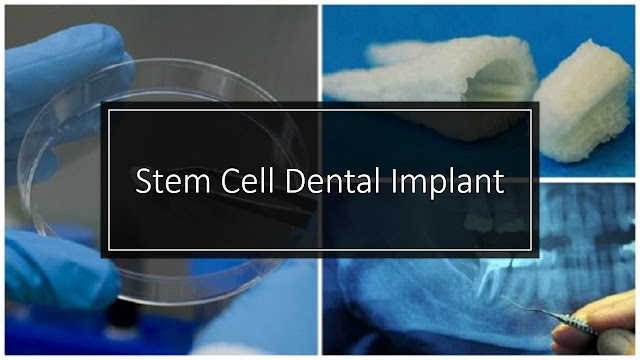Stem Cell Dental Implants might one day be alternative to Dental Implants and Dentures
Although dental implants have a success rate of more than 95 percent, there is always a risk for complications and infection, including injury to the nerves, sinuses or nasal cavity. In some cases, the implant fails to fuse to the jawbone, or can break or crack.
(Chron) - Those seeking treatment for missing teeth can usually expect to replace them with dentures, dental bridges or dental implants. For damaged teeth that can be saved, there are crowns, fillings and root canals. However, researchers are pointing to an alternative to standard forms of treatment — growing or repairing one's own teeth with the use of human stem cells.
Dr. David Mooney, bioengineering professor at Harvard University's Wyss Institute, led a study that demonstrated the ability of a low-power laser to trigger human dental stem cells to form dentin, the hard tissue underneath the tooth's enamel. The laser treatments triggered the dentin formation after about 12 weeks, based on high-resolution x-rays and microscopy.
Alternatively, researchers at Columbia University, led by Dr. Jeremy Mao, professor of dental medicine and director of the Tissue Engineering and Regenerative Medicine Laboratory, found success by directing stem cells to colonize a three-dimensional scaffold made of natural materials. After about nine weeks, Mao's study achieved regeneration of anatomically correct teeth.
In an article authored by Mao in the New York State Dental Journal (NYSDJ), Stem Cells and the Future of Dental Care, he contends that stem cell research and development will, over time, transform dental practice in a magnitude far greater than the use of dental fillings or dental implants. He also acknowledges the need for dental practitioners to prepare themselves for the upcoming era of stem-cell based technologies.
Dr. Bill So, owner of Westway Park Dental and TranscenDental Smiles of Memorial, has practiced dentistry for 17 years. He routinely treats cavities and tooth decay with root canals, fillings or crowns. In cases where teeth cannot be saved — or when patients are missing teeth congenitally or because of an accident or trauma — a referral to an oral surgeon, endodontist or periodontist is usually the next step.
Depending on their financial or personal situations, many patients wait to replace missing teeth or go without treatment. But, living with the loss could result in further damage. Effects of missing teeth include bone loss in the jaw, shifting teeth, difficulty chewing and bite irregularities. Speech issues can develop, and the face loses support and structure.
Restorative options are costly, however, and not always covered by insurance. Implants, nowadays considered the gold standard when it comes to tooth replacement, can take as long as three to six months depending on the type and number of implants needed, the patient's bone structure and the success of the implant fusing into the jawbone.
"One implant alone can cost $1,000 to upwards of $3,000, and this doesn't include the cost of bone grafts and other parts of the procedure," So said. "The cost can easily go up to the tens of thousands if we're talking about replacing multiple teeth."
And, although implants have a success rate of more than 95 percent, there is always a risk for complications and infection, including injury to the nerves, sinuses or nasal cavity. In some cases, the implant fails to fuse to the jawbone, or can break or crack.
"Being able to grow your own teeth, possibly using your body's own cells, would be an exciting option for patients, and a huge step in improving one's quality of life," So said. "By reading journals, taking continuing education courses, and participating in forums, it's exciting to see that dentistry is constantly evolving and that researchers are making leaps and bounds."
Despite the promising research, the ability to see a dentist and ask for the option to grow one's teeth is still years, even decades, in the making.
"The use of dental-derived stem cells for tooth regeneration procedures in humans is not yet allowed in the United States. While pre-clinical studies in animal models show promising results, performing clinical trials in humans will still require some time as many scientific and regulatory issues and challenges need to be addressed before these cells can be employed in clinical therapy," said Dr. Ariadne Letra, associate professor in the Department of Diagnostic and Biomedical Sciences at The University of Texas Health Science Center at Houston (UTHealth) School of Dentistry.
In her own work, Letra has seen that tissue engineering with the use of stem cells and growth factors is a viable option and an attractive strategy for dental tissue regeneration, but it's not as simple as being able to sprout a new tooth from an empty socket.
"The tooth is a very complex organ, with three distinct tissues (enamel, dentin and pulp) that comprise its anatomy," Letra said. "Since teeth and surrounding bone tissues are functionally connected at many levels, growing or regenerating an entire new functional human tooth is still a significant challenge. While this is possible in the future, dental implants or dental prosthesis are still recommended for tooth-replacement therapies."




.png)




Comments